April / May 2016
After I had applied for my visa in the Uzbek Embassy in Dubai, I was curious if I could pick it up without difficulties in Bishkek, the capital of Kyrgyzstan. The Uzbek embassy in Bishkek is known for the rude tone and multi-day delays in the visa process. However, I got the visa without problems. I immediately booked a flight for the next day to Uzbekistan.
At the airport of Tashkent, the capital of Uzbekistan, I wondered by what degree my luggage will be examined. The Uzbek customs authorities sometimes check each photo on the computer or smart phone, which can take up to an hour. This is to ensure that no photos with naked people or propaganda come to Uzbekistan. Since all currencies must be declared, the imported money is checked sometimes. I apparently made a good impression on the customs officer, because I came without any control through customs, after he had made sure that the 4’722’000 Indonesian rupees that I mentioned on the declaration form merely corresponded to about 330 US dollars.
Uzbekistan is a police state. In the capital policemen can be found every few hundred meters. At the entrance to all subway stations there are checkpoints where foreigners must show their passport and visa. Each hotel must register foreigners and issue a registration certificate which the tourists must show when leaving the country. Skype is blocked and the internet is very slow. Buying a SIM card takes about 1 hour and the load is merely valid one week. The reloading of a credit takes 1 hour again. Of course, the passport and visa must be presented again. The currency of Uzbekistan is the Som. The official rate (ca. 2’900 Som for one US dollar) is far from the market price, so I changed my US dollars on the black market (about 6’400 Som for one US dollar). Thanks to the black market, Uzbekistan was with Kyrgyzstan the cheapest country on my trip.
Tashkent
Tashkent is a city with great boulevards and magnificent oversized buildings of government bodies and state-owned companies. But just a few kilometers outside the center are crumbling buildings and old cars everywhere.
In Tashkent I first met Amir Temur in the form of an equestrian statue. In the West, he is also known as Tamerlane. He is the national hero of Uzbekistan and lived in the 14th century. His aim was to restore the empire of Genghis Kahn’s, that reached its peak at the end of the 13th century and that was the largest empire that ever existed in human history. He did not reach his goal though. But he and his army conquered within a few decades Central Asia and could expand its territory as far as Syria. His campaigns brought untold suffering to the civilian population that was robbed, murdered and raped. After his death, much of the empire fell over the next three generations and one of the grandchildren even killed his father (and Amir’s son).
The statue of Amir Temur, Uzbekistan’s national hero

Worth seeing in Tashkent is the Chorsu bazaar, selling everything possible. Bread is the staple food of the Uzbeks. Therefore, there is a large bread sale zone, where some of the bread is baked as well. From animal here every part is used, so that you can admire and buy all kinds of offal, feet, tails and fat lumps.
As western visitor to the opera house, I got a private tour through the extensively renovated house. During the break I visited the Opera Cafe, where a glass of vodka was offered cheaper than a coffee.
I wanted to visit an Uzbek gourmet restaurant. Too bad that they are in New York, Moscow and Riga. The Uzbek cuisine is limited to a few dishes that are indeed prepared sound and taste good but miss sophistication.
Khiva
Next I visited the approximately 1,000 km distant desert town Khiva. The small town and the city wall is fully preserved. Nevertheless, it is also an ordinary Uzbek city with a market where both food as well as tools or SIM cards are sold. You can watch how the locals weave rugs, carve wood or make silk. As the photos show, I liked it there very much. The area around Khiva was fought since time immemorial, so that there are about 20 forts in the radius of 50 km.
The stumpy tower is the Kalta Minor Minaret. The work ceased after the death of the sponsor Mohammed Amin Khan.
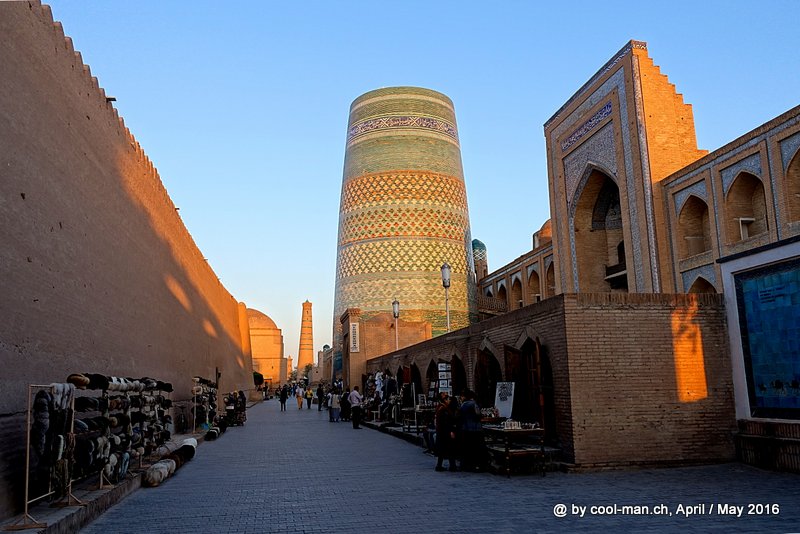
The minaret of the Islom-Hoja Medressa, Uzbekistan’s highest at 57 meter tall.
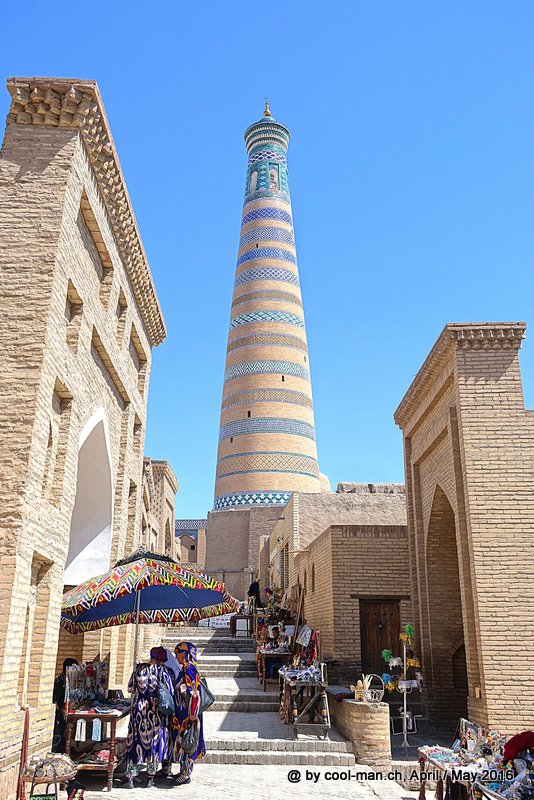

Khiva‘s picturesque old town is an ideal place for weddings.

Allakuli Khan Medressa

The wooden pillars are carved using traditional patterns.
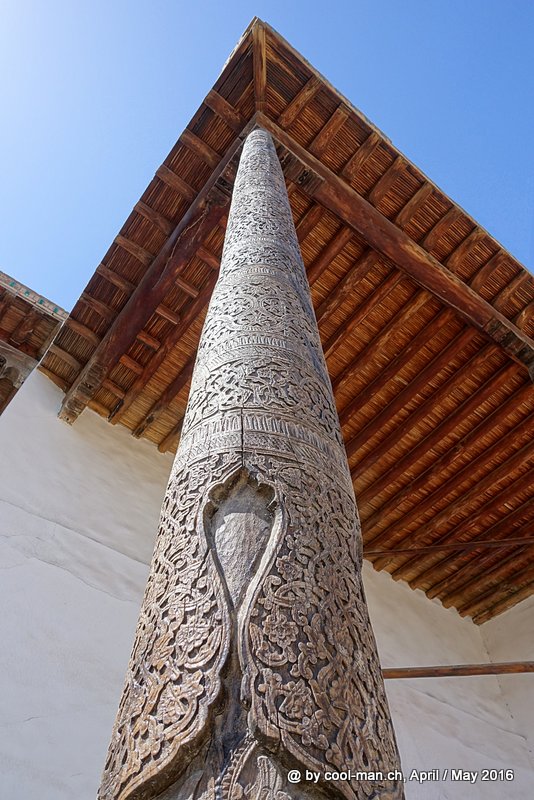
Because of the ban on pictures in Islam, many surfaces are decorated with beautiful patterns.

Bread is baked in a traditional clay oven. The dough is first decorated and then pressed against the oven wall.
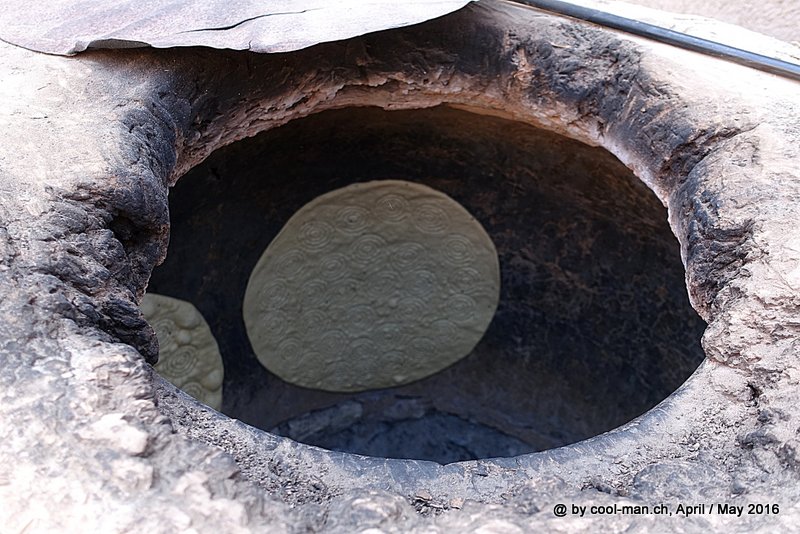
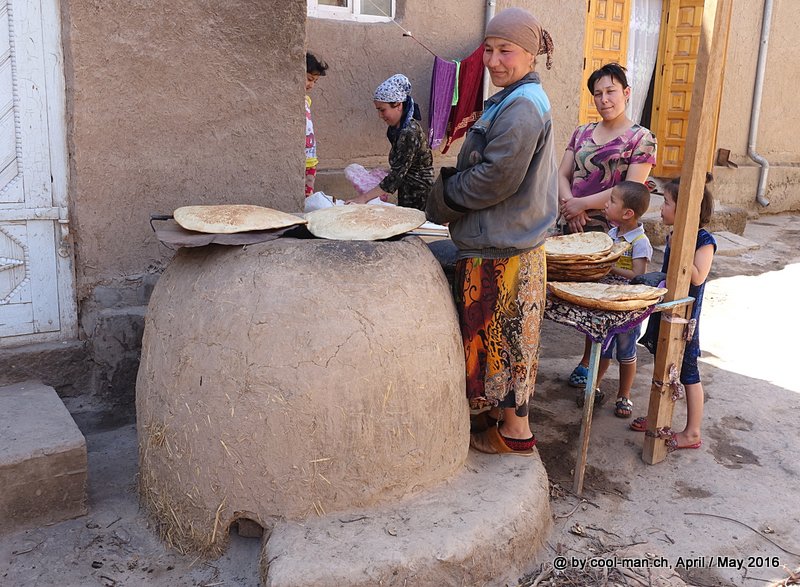
It takes months to knot a carpet.
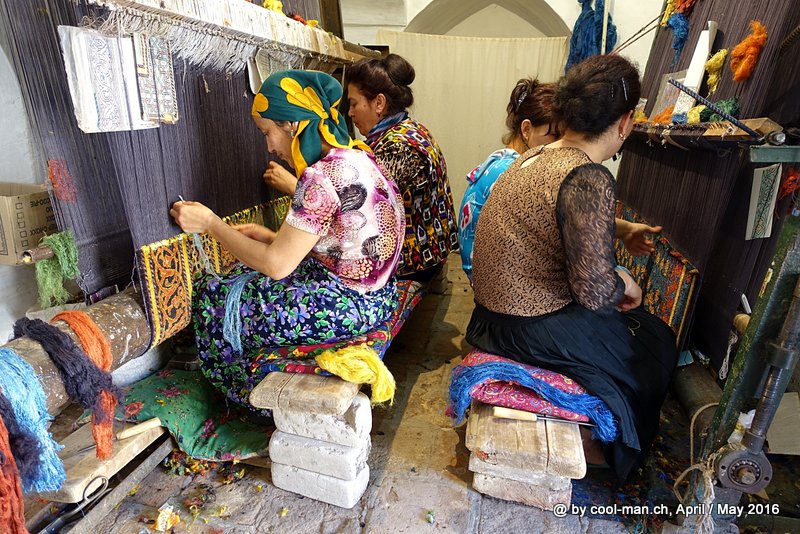
At the market
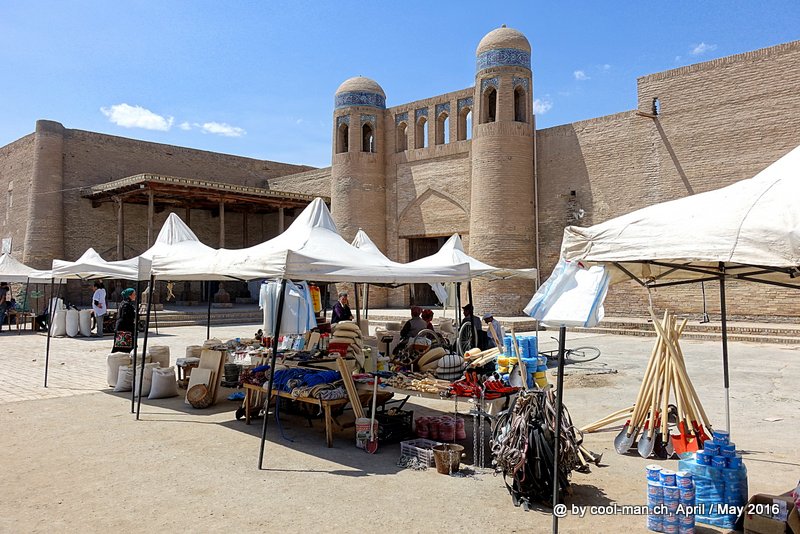
They liked my joke.

All doors are beautifully adorned.
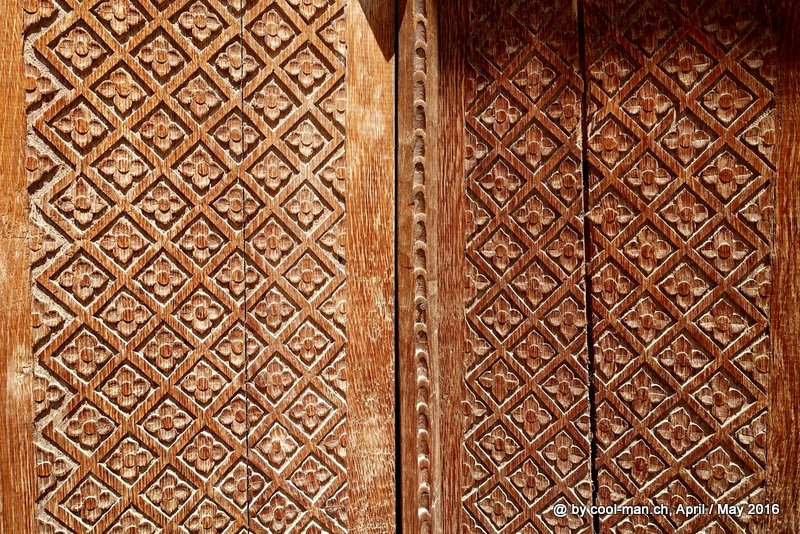
Pahlavon Mahmud Mausoleum

Khorezm
The Ayaz Qala Fortress – This strategic area was once an oasis and therefore, armed conflicts were frequent.
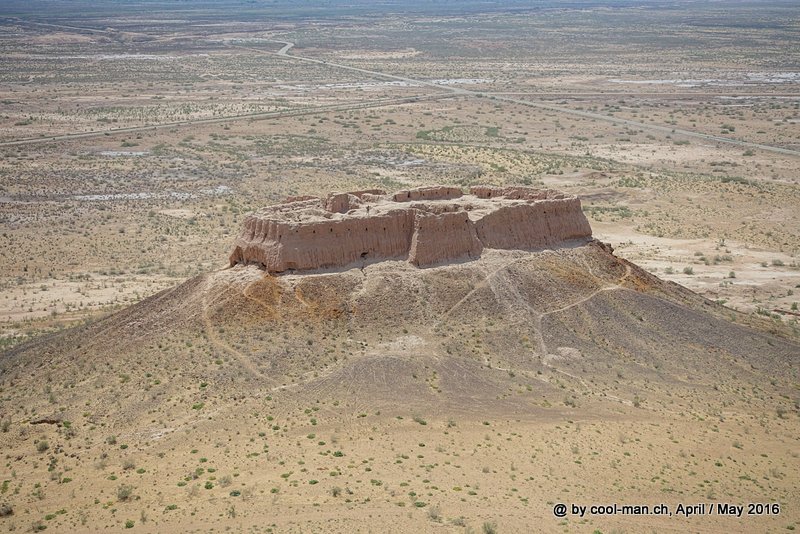
Samsas are everywhre in Uzbekistan – It’s a pastry filled with lamb or beef, potatoes, vegetables and fried onions.
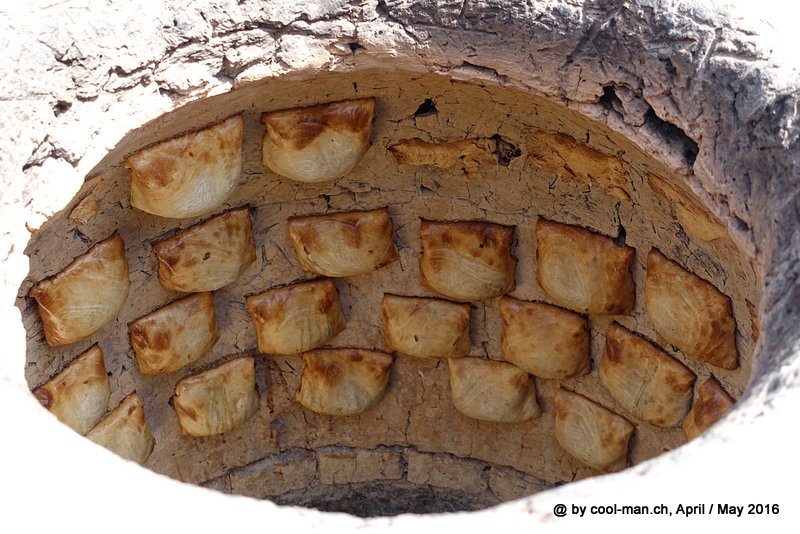
Since this desert region is sparsely populated, there is no bus service to Bukhara that is about 450 km away, the nearest major town east of Khiva. If there is no bus in Uzbekistan, the travelers share a taxi, that only leaves when it is full. I took the taxi with an English couple that I met in Khiva.
Bukhara
Bukhara as one of the most important trading centers on the Silk Road can look back on several millennia. The historic center is located away from the bustle of the modern city, so when viewing the imposing, almost a thousand year old monuments, I felt in a meditative mood. Decorated market halls, meter-thick walls and the oldest Muslim mausoleum in Central Asia are some of the highlights. However, the most beautiful place is the square in front of the Kalon Mosque, with its nearly 900 year old, 47 meters high, beautifully decorated minaret. On the other side of the square is the Mir-i-Arab Madrasa with its bright blue dome.
The main sight in Bukhara – On the left the Mir-i-Arab Medressa, a koran school and on the right the Kolan mosque with its minaret. Built in 1127, with 47 meters, it was the tallest building in Central Asia at that time.
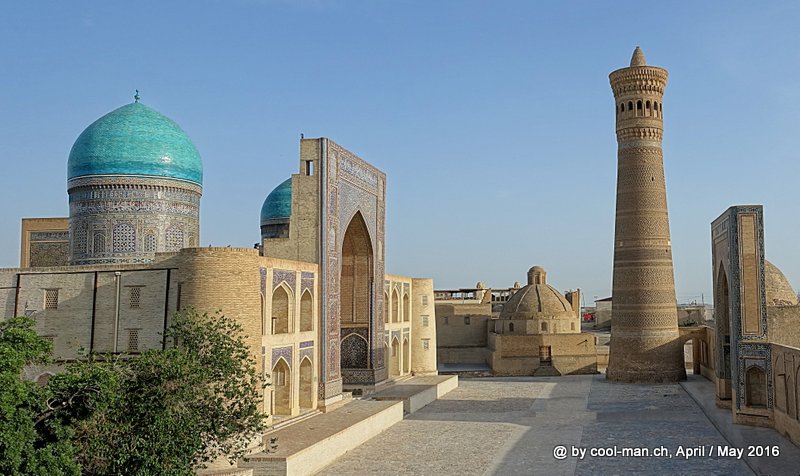

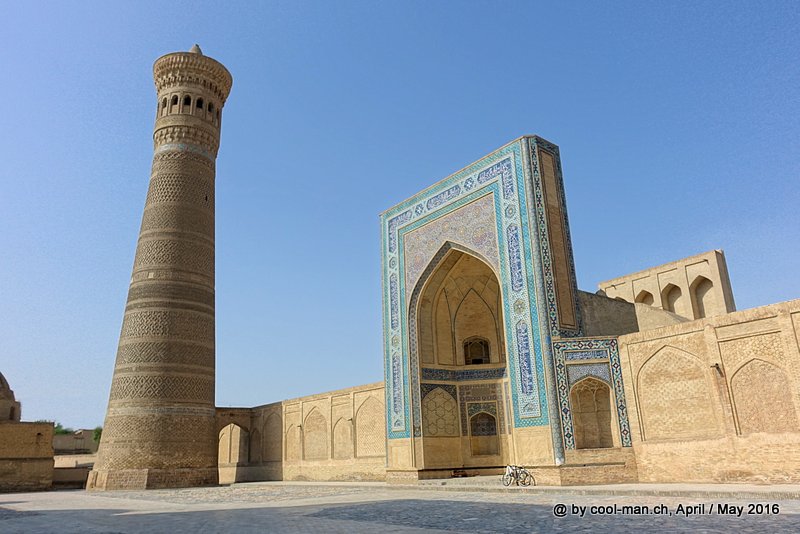
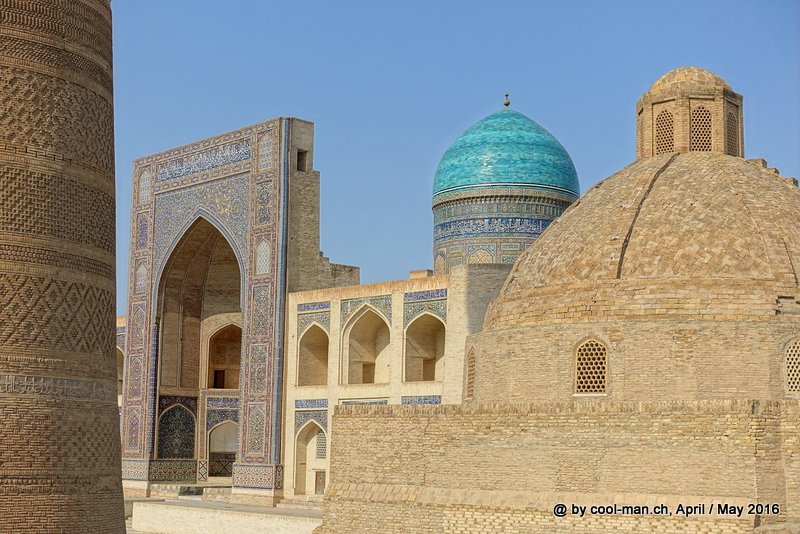
A gatehouse of a long-gone university

This ornate tomb from the 10th century is the oldest Muslim building in Central Asia.

The Bolo-Hauz Mosque with beautifully ornate wooden columns, which are typical of the Uzbek architecture

Samarkand
By train I traveled to Samarkand, the city with the most imposing monuments in Central Asia. The Registan complex is a huge place, that is lined by three centuries old, stunning koran schools. Each contains dozens of rooms with colorful ceilings, countless mosaics and huge entrance gates.
Registan
Samarkand’s medieval commercial center encompasses three magnificent koran schools. For many, it is the highlight of a trip through Central Asia.
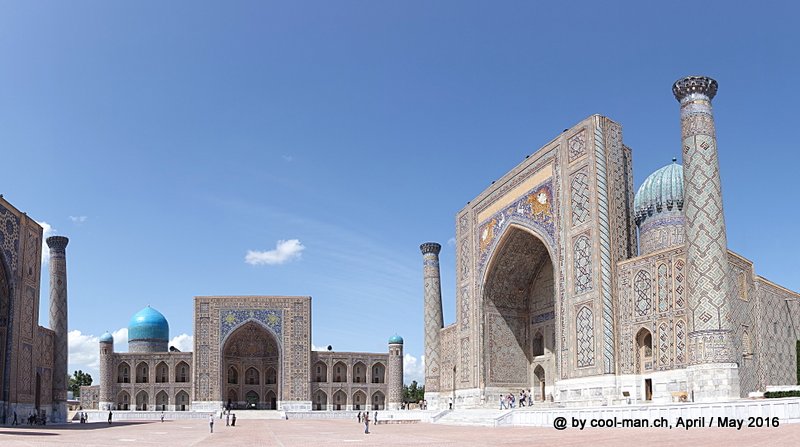
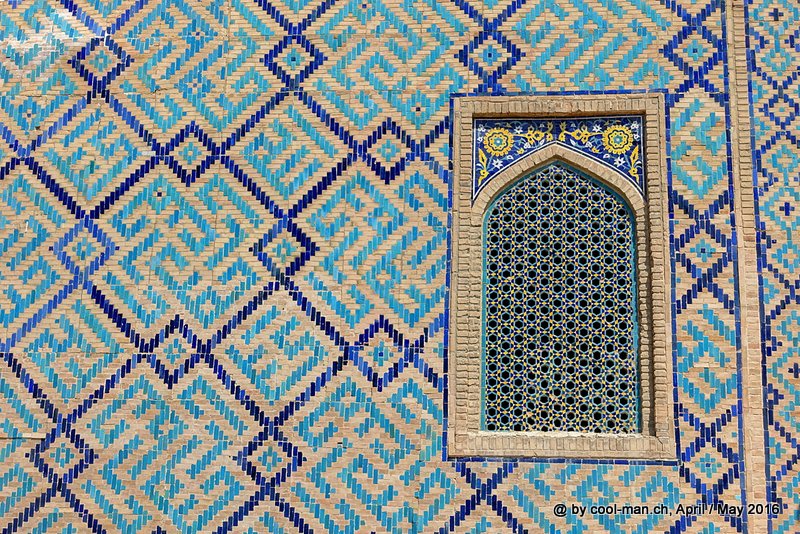


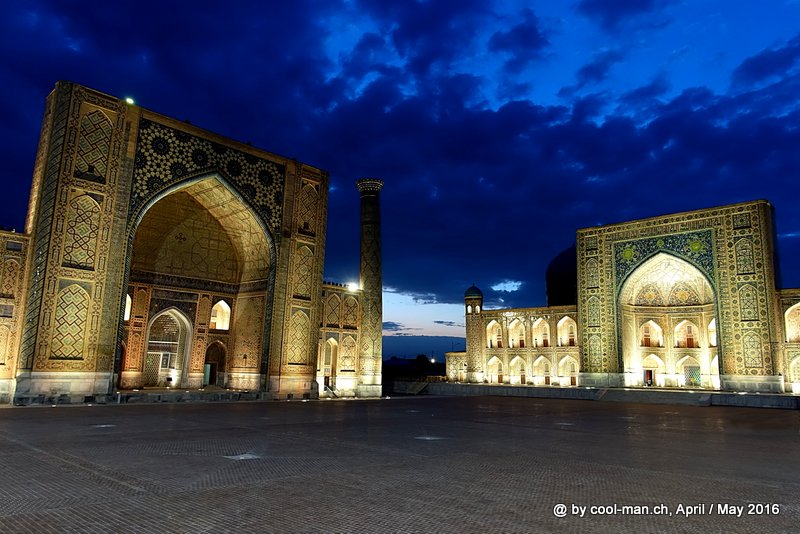
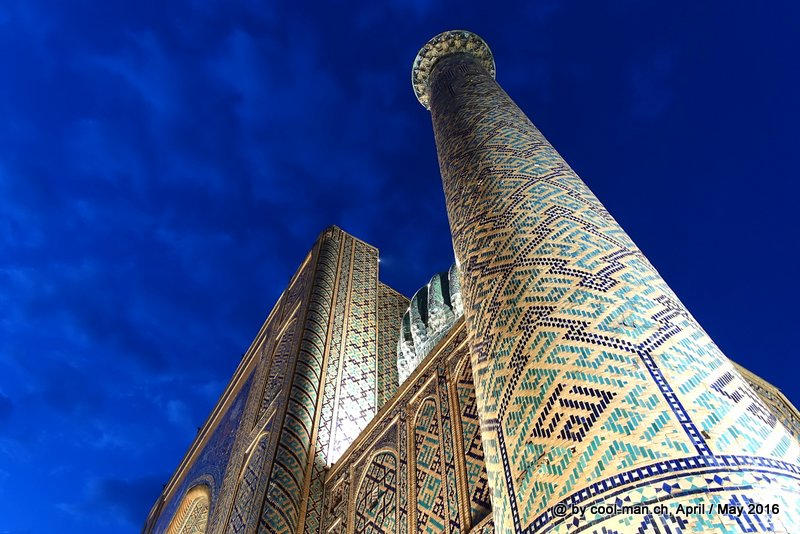
Gur-e-Amir Mausoleum
The Gur-e-Amir Mausoleum is a great building, which is not surprising, as it is the tomb of national hero Amir Temur, two of his sons (one is Ulugbek, who was beheaded by his own son) and two grandchildren. As the Soviet anthropologist Mikhail Gerasimov and his team on June 20, 1941 opened the grave, they found an inscription that the molester of this tomb would encounter a more formidable opponent as Amir. Two days later, Hitler attacked the Soviet Union. In 1942 Timur was buried with Muslim rites a second time. Then the tide turned for the Soviets and they managed the decisive victory in WW2 in the Battle of Stalingrad. For the Uzbeks there is a clear link between these events. Amir’s curse should still withstand, but no one dares to prove the opposite with a renewed grave opening.
The mausoleum of Amir Temur, the national hero of Uzbekistan


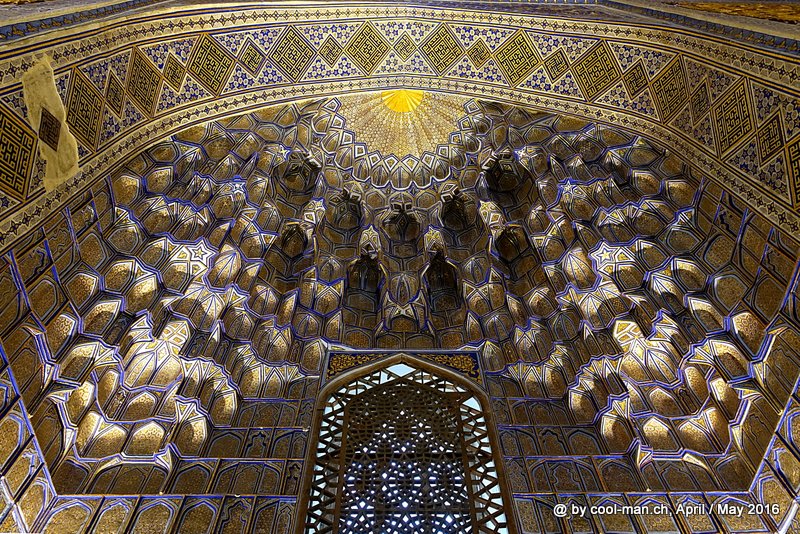
Avenue of Mausoleums (Shah-i-Zinda)
Another highlight in Samarkand was the so-called Avenue of Mausoleums (Shah-i-Zinda). Along a path you find dozens mausoleums, all decorated with wonderful tiles, which are among the most beautiful in the Muslim world. A cousin of Prophet Mohammed and relatives and friends of Amir Temur’s family are buried here.
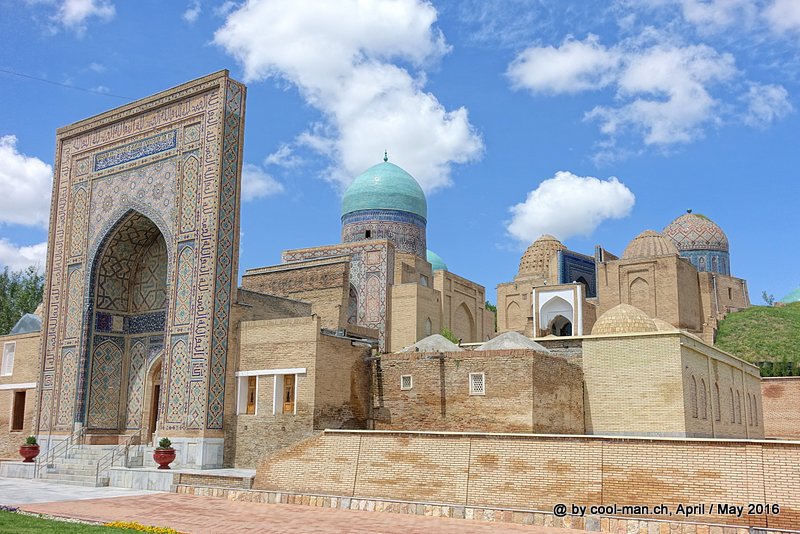
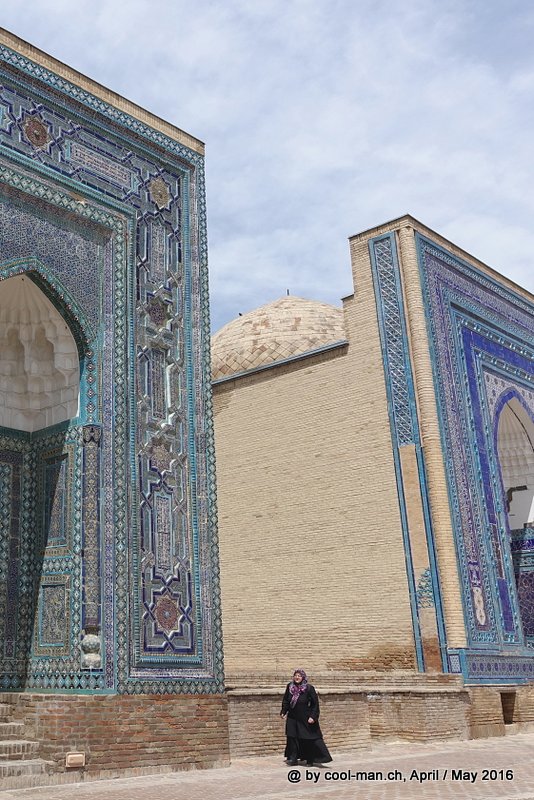
The Uzbek people love western tourists. I was asked to pose with locals for photos again and again. After some time I started to demand that photos with my camera were taken, too.
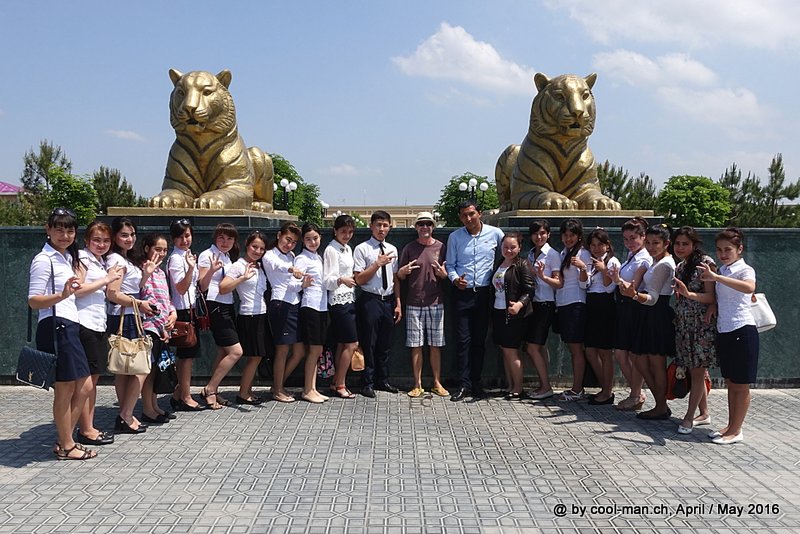
Via Tashkent I traveled eastward over a mountain pass into the Fergana Valley. Even Samarkand is no longer part of the desert. But the Fergana valley is the most fertile and the most densely populated part of Uzbekistan. The main agricultural product is cotton. And the ceramic crafts and silk production flourish. Thanks to the mild climate cherries, apricots and strawberries were already ripe in May. The wealth of this area is evident in the beautiful houses and orderly cities. As the valley was in the past origin of extremist Islam (which was brutally suppressed) and because of the proximity to the warring Kyrgyzstan, all foreigners entering the valley must register.
Kokand
Kokand was my first destination in the valley. It is a tarted Town. The palace of the Khan dynasty, who ruled the area in the 18th and 19th centuries, is the main attraction. It includes 7 courtyards and 114 rooms. Its outer walls are covered with wonderfully skilful tiles. Half of the palace housed the harem of the khan.
Cleaning never ends in this 114 room palace.
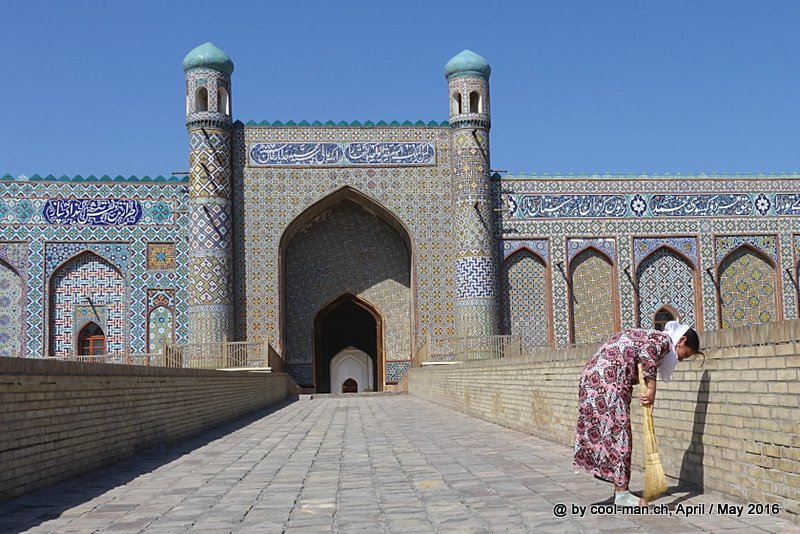
Rishton
From Kokand I made a trip to Rishton, the Uzbek center of pottery production. It was interesting to see how many processes are necessary to create the ceramics. The elaborate paintings on the plates, cups and vases impressed me. Then I visited the market in Rishton. Apparently not many tourists come there because I and a German woman were the attraction.
Beautiful gold teeth
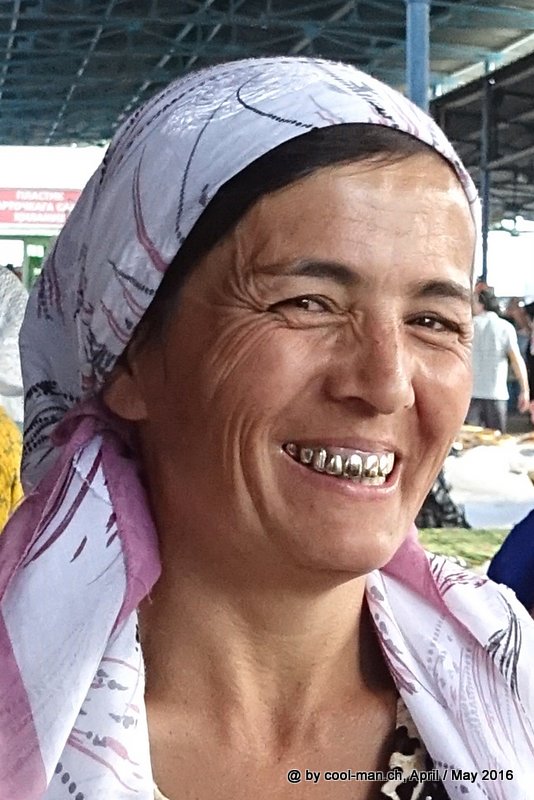
Fun in the bakery

The next town on my route was Fergana, where I made a trip to Margilan, the two thousand year old center of silk production in Uzbekistan. Families breed silkworms in large numbers in order to obtain an additional income. The silk worms eat only mulberry leaves, Thus, a sufficient number of trees needs to be available. At the end of their development, the worms pupate by spinning a single about one kilometer long silk thread to a cocoon.
Andijon
My last stop on my trip in Uzbekistan was Andijon, a city visited only by the few tourists who cross the border into Kyrgyzstan. There are few sights, but the market was interesting. In addition to many everyday objects and food I found craft enterprises as tinsmith or blacksmith who still worked by medieval methods.
This blacksmith and his apprentice are proud of their work
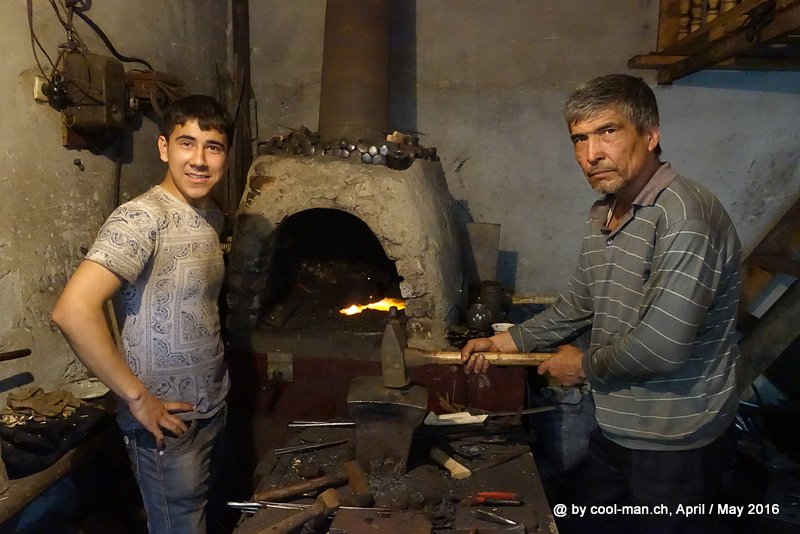
Catching attention with funny sunglasses to sell the local bread
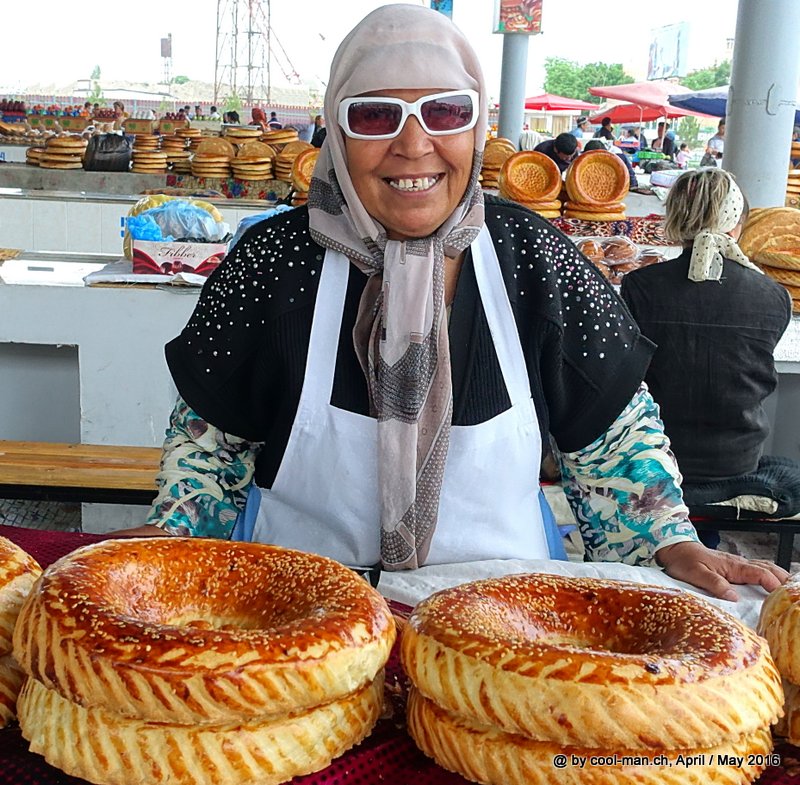
The next day I crossed the border into Kyrgyzstan. The Uzbek authorities are still thinking in terms of the Cold War. I heard that each image on the mobile phone or laptop is checked when leaving, as it might be a picture of a military facility, a bridge or an airport. The exported amount of money must be smaller than the imported, otherwise you would have worked black or otherwise committed an illegal activity. I had multiple Windows Recovery DVDs with me and feared that I have problems because I could save all sorts of information on them and would probably being suspected to be a spy. When I arrived, there was merely an old woman with a child crossing at this boundary in no man’s land. After checking my passport and exit form the custom officer looked a few seconds in my suitcase before he let me pass. I was relieved.
I liked Uzbekistan very much. The country was one of the most interesting on my journey. Most Uzbeks are very friendly and honest, which makes traveling easy. Some people speak English. If I no longer came forth, I could still rely on the Google Translation app. Since only about 10 individuals from the west were on my route at the same time, I met the same people again and again, became friends and with whom I undertook trips or went to eat. Finally, I would like to mention Xalva (pronounced Halva) a semi-hard sweet of sugar, honey, pine nuts and other secret ingredients according to family recipes. Simply delicious! For this reason alone Uzbekistan is worth the trip.
This text is an automatic English translation from the German original by deepl.com